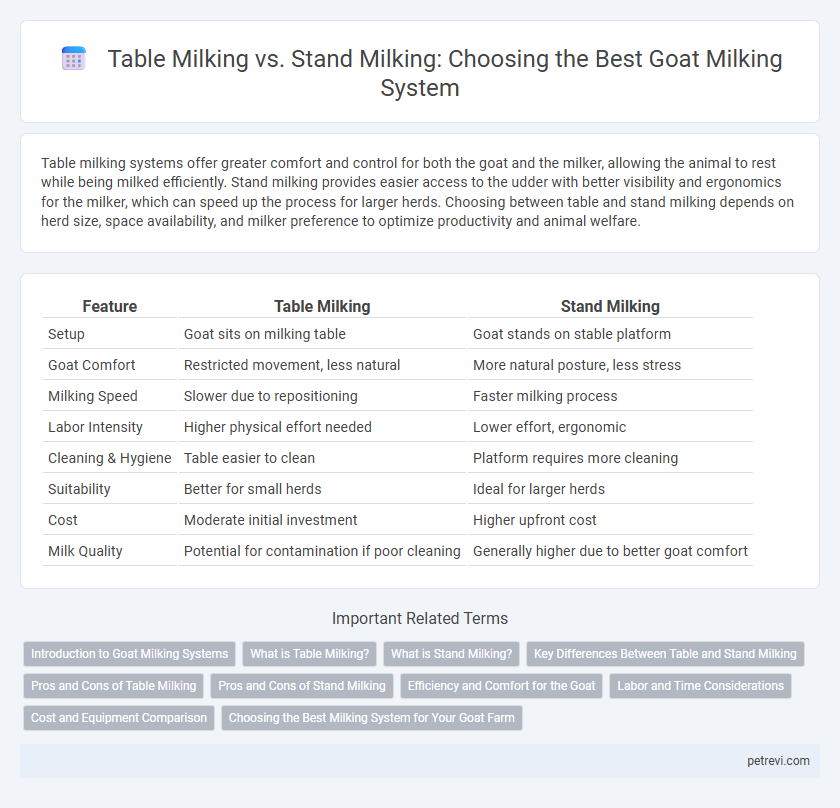Table milking systems offer greater comfort and control for both the goat and the milker, allowing the animal to rest while being milked efficiently. Stand milking provides easier access to the udder with better visibility and ergonomics for the milker, which can speed up the process for larger herds. Choosing between table and stand milking depends on herd size, space availability, and milker preference to optimize productivity and animal welfare.
Table of Comparison
| Feature | Table Milking | Stand Milking |
|---|---|---|
| Setup | Goat sits on milking table | Goat stands on stable platform |
| Goat Comfort | Restricted movement, less natural | More natural posture, less stress |
| Milking Speed | Slower due to repositioning | Faster milking process |
| Labor Intensity | Higher physical effort needed | Lower effort, ergonomic |
| Cleaning & Hygiene | Table easier to clean | Platform requires more cleaning |
| Suitability | Better for small herds | Ideal for larger herds |
| Cost | Moderate initial investment | Higher upfront cost |
| Milk Quality | Potential for contamination if poor cleaning | Generally higher due to better goat comfort |
Introduction to Goat Milking Systems
Table milking and stand milking represent two primary goat milking systems designed to enhance efficiency and animal comfort. Table milking involves securing goats on elevated platforms, improving accessibility and reducing strain on operators, while stand milking offers a more compact setup with goats positioned on lower stands, suitable for smaller operations. Both systems prioritize hygiene and ergonomic handling, with variations in infrastructure tailored to herd size and milking frequency.
What is Table Milking?
Table milking is a method where goats are positioned on an elevated milking table, allowing the milker to access the udder at a comfortable height, improving efficiency and ergonomics. This system facilitates easier handling and reduces stress for both the goat and the milker, often resulting in cleaner milk and faster milking times. Compared to stand milking, where goats remain on the ground, table milking enhances control and hygiene by providing a designated, elevated workspace.
What is Stand Milking?
Stand milking is a goat milking method where the animal stands on an elevated platform or stand, allowing easier access for the milker to reach udders comfortably. This system enhances hygiene by minimizing dirt contact and simplifies handling, thereby improving milking efficiency. Stand milking is preferred in many dairy goat farms for its ergonomic benefits and better control during the milking process.
Key Differences Between Table and Stand Milking
Table milking systems position goats on elevated platforms, allowing farmers easy access while seated, optimizing ergonomics and reducing fatigue during milking. Stand milking involves goats standing on the ground or a lower surface, requiring the milker to bend or crouch, which can slow the process but often requires less specialized equipment. Table milking is preferred for larger herds due to increased efficiency and improved udder access, while stand milking suits smaller operations focused on simplicity and minimal setup costs.
Pros and Cons of Table Milking
Table milking in goat milking systems offers enhanced udder support and better accessibility, leading to improved milking efficiency and reduced risk of injury for both goats and handlers. However, it requires significant investment in specialized equipment and occupies more space compared to stand milking setups. While table milking facilitates easier cleaning and monitoring of individual goats, it may not be suitable for large-scale operations due to slower throughput.
Pros and Cons of Stand Milking
Stand milking systems for goats provide enhanced control and hygiene, reducing contamination risks and improving udder health through elevated positioning. This method offers ergonomic benefits by minimizing physical strain for the milker and enabling consistent, efficient milk extraction. However, stand milking may require higher initial investment in equipment and space, and some goats might experience stress or discomfort adapting to the raised platform.
Efficiency and Comfort for the Goat
Table milking systems enhance efficiency by allowing better control over the goat's positioning, resulting in faster milking times and improved milk quality. Stand milking offers greater comfort for the goat by permitting natural posture and less restraint, reducing stress and promoting consistent milk letdown. Choosing between the two systems depends on balancing operational efficiency with the animal's welfare to optimize overall productivity.
Labor and Time Considerations
Table milking systems for goats significantly reduce labor intensity by allowing multiple animals to be milked simultaneously, streamlining the milking process and saving time. Stand milking requires individual handling of goats, increasing both labor demands and duration per milking session. Efficiency gains in table milking translate to higher productivity and lower labor costs in goat dairy operations.
Cost and Equipment Comparison
Table milking systems for goats typically involve a raised platform and milking stand that simplifies goat handling, resulting in higher upfront equipment costs averaging $800 to $1,200 but reduced labor time. Stand milking systems are lower cost, often under $500, using basic milking stands or stalls, but may require more manual labor and time per session. Investment decisions between table and stand milking hinge on balancing initial equipment expenses against long-term labor efficiency and milk yield consistency.
Choosing the Best Milking System for Your Goat Farm
Table milking systems offer increased efficiency and ergonomics for small to medium-sized goat farms by allowing goats to be securely placed at a comfortable height, reducing strain on farmers during the milking process. Stand milking systems are ideal for larger herds, promoting better goat handling and hygiene through designated milking stalls that facilitate organized flow and reduce stress on animals. Selecting the right milking system depends on herd size, labor resources, and farm layout to optimize milk yield and animal welfare.
Table milking vs Stand milking for Goat milking systems Infographic

 petrevi.com
petrevi.com